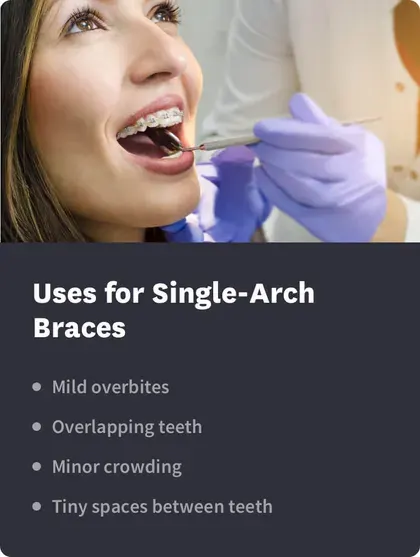Can You Get Braces Just for Your Top or Bottom Teeth?

Table of Contents
- How Braces Help
- Recommended Approach
- Which Is More Popular?
- Braces for Just Top or Bottom Teeth
- Why Bite Alignment Matters
- Risks & Drawbacks
- Detailed Cost Comparisons
- Twice the Braces
- Savings
Yes, you can get braces on either the top or bottom, without getting braces for both jaws. This is generally because you only have a few misaligned teeth in one location.
However, this approach may not necessarily be faster or less expensive. There might be some underlying dental alignment problems that could benefit from having braces on both jaws.

Braces for Just Top or Bottom Teeth: What Can They Treat?
When braces are applied to only one jaw (either the upper or lower), it is single-arch treatment or one-arch orthodontic treatment.
Braces may be applied to only the bottom teeth in rare cases, such in children who are just beginning orthodontic treatment and have most of their issues in their bottom teeth or in individuals whose teeth are relatively straight.
This approach might be used for the following conditions:
Minor malocclusion issues
Significant overbite in people who have straight top teeth and crowding in the bottom teeth
Overbite involving straight bottom teeth and gaps in upper teeth
Underbites that feature bottom teeth and crowded top teeth
More than Beauty: How Braces Help your Bite
A healthy, beautiful smile exposes all of your central and lateral upper incisors, beauty experts say. The rest of your teeth stay covered by your lips when you smile. Shouldn't you focus your braces on the parts of your teeth others can see?
It's critical to remember that your teeth aren't beauty accessories. You also use those teeth for tasks like these:
Your tongue taps on your teeth for hard consonant sounds, and your voice reverberates and echoes through the enamel. If you have gaps in your teeth or a pronounced overbite, there may be a slight whistling sound when you talk that sounds like a lisp.
We use sharp front teeth to bite food.
Back teeth are essential for breaking down food.
Bite Alignment: Why It Matters
Your teeth don’t work in isolation. Instead, they’re part of a delicate network that you rely on every single day. If you focus on just the upper or lower teeth, you may experience problems in several areas, including the following:
Your Bite
Your teeth click every time you close your mouth. If you change just one set of teeth, the way they connect and combine could be changed in an unhealthy way.
For example, you may have one lower tooth that’s pushed slightly forward. If you change your upper teeth, those lower teeth could hit their upper counterparts and chip, crack, or fracture.
Addressing both arches simultaneously allows your dental team to spot these conflicts and prevent them before they cause harm.
Your Function
Researchers say most people seek orthodontic treatment because they’re concerned about how they look. While your appearance is certainly important, your teeth must work hard too. If you use braces for just top or bottom teeth, they may not function properly as a unit.
For example, you may use lower-arch treatment to straighten your front lower teeth. However, when that work is done, you may realize that your upper teeth are pushed forward just slightly. When your lower teeth were crooked, you could compensate. Now, you can’t. As a result, you can’t bite effectively.
Treating both arches means spotting and fixing these functional issues, even if you can’t see them in the mirror.
Your Comfort
Your teeth rely on muscles to move your jaw. As the American Dental Association (ADA) explains, the temporomandibular joints (TMJ) make opening and closing your mouth possible. The ADA also explains that your tooth and jaw alignment can cause TMJ pain.
For example, if you shift your upper teeth forward, you may need to change how you eat, speak, and open your mouth. Those adjustments could cause pain, especially if your teeth no longer nest properly.
Risks & Drawbacks of Braces for Just Top or Bottom Teeth
Your teeth don't work in isolation. Upper and lower sets come together to form your bite, and even tiny adjustments can have big repercussions. Potential consequences include the following:
Dental damage: Adjust just one part of your mouth, and your front and back teeth could come together with excessive force. You could chip or crack your teeth each time the set comes together. You could also exert too much pressure on your bone and gums.
Reduced function: Changing just one part of your bite could stop your teeth from meeting at all. A big gap could make chewing impossible, and it could put excess strain on your muscles and tendons.
Uneven wear: Your teeth come together and share the workload when you chew. Braces for just the top or bottom teeth could keep your teeth from touching or working together properly. Their new positions could also cause them to come together in less than ideal ways. You could experience unsightly wear on your teeth. In time, that poor wear could lead to tooth loss.

Do Experts Recommend this Approach?
Dental professionals are concerned with cosmetic factors. They want your smile to look as beautiful as possible. But they are also concerned with mouth mechanics and overall health. You might notice that only one part of your teeth looks crooked or unusual. A dental professional might see something very different. Some dentists say single-arch braces are appropriate for minor tooth movement, including these issues:
Mild overbites
Overlapping teeth
Minor crowding
Tiny spaces between teeth
But other exerts, including aligner companies like Byte, don't offer this form of treatment. Teeth should be adjusted in unison, they say, and it's just too risky to treat some teeth while leaving the others untouched.
Minor issues, such as gapping teeth, can be adjusted with just one set of braces or aligners, but most experts recommend treating both your top and bottom teeth at the same time, so you preserve your bite and your oral health.
Will You Save Money?
Consumers often think of dental treatments as packages. If you cut the needed therapy in half by treating one set of teeth and not the other, you should save money, right? Experts don't always agree.
To adjust your smile, dental professionals must do the following:
Dental impressions, photographs, and more help dental experts identify how your teeth should move.
Your team must figure out which teeth should move, and they often must assess movement sequences. Some teeth must move first so others can fill in the gaps, for example.
Your team must provide braces or aligners to help those teeth move.
Your team must check in with you to ensure that the plan is working and your teeth are shifting.
These same steps apply whether you're moving one set of teeth or both. If you're hoping to skip movement on one arch to save a chunk of money, you might be disappointed.

Detailed Cost Comparisons
This chart can help you understand the potential fees associated with each type of braces we’ve discussed:
Type of Treatment | Pros | Cons | Potential Cost |
Top teeth only | Less noticeable | Could worsen bite problems | $3,000-$7,000 |
Bottom teeth only | Less noticeable | Could worsen bite problems | $3,000-$7,000 |
Full braces | Most effective and safest option | More noticeable | $5,000-$10,000 |
Twice the Braces
You want to improve your smile, but you want to save money. And you want to ease pain. There are plenty of things you can do to meet your goals without putting your health and your bite at risk.
If you're considering single-arch braces due to these common concerns, it's time to think again. Here are some of the disadvantages:
Single-arch braces may not save you money. But many aligner companies and orthodontists offer payment plans that help you improve your smile without harming your budget. You can also use health savings accounts (HSAs) and health insurance to help you pay for care.
Moving your teeth can be uncomfortable, but it shouldn't be overly painful. If you're concerned about how much braces will hurt, consider aligners. They won't cut up your lips the way braces might, and many people find that they are more comfortable than braces.
Braces on your top and lower teeth are hard to miss. You could opt for porcelain braces, which have white brackets others may not notice. Or you could use clear aligners that are very difficult to spot.
If you're not sure that you need help with both your top and bottom teeth, talk with a dental expert. Let that person explain how your teeth come together and why adjusting your bite is critical. You might find your concerns fade.
Your smile showcases your beauty. But your teeth are critical to your health. Don't let misconceptions keep you from the care you need. Ask questions and do your homework to ensure that you get the treatment that's right for your mouth and your health.
Are Braces on the Top or Bottom Teeth more Popular?
Because the upper teeth are more noticeable, and the most common type of malocclusion is class 1 malocclusion (which often involves teeth misalignment in the upper teeth), when it comes to single-arch treatment, braces on the top teeth may be more popular.
However, single-arch treatments are not popular in general, as most orthodontists and aligner providers prefer to treat the bite as a whole. This is because they know how closely the upper and lower jaw and teeth interact with one another and how much more effective and predictable two-arch (regular) orthodontic treatment is in general.
